Blog - Foot Doctor, Chambersburg and McConnellsburg, PA
How to Practice Proper Foot Care
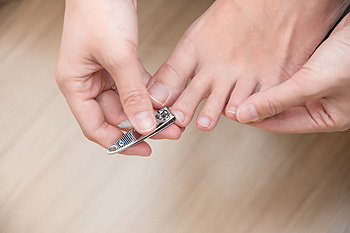 You should always take care of your feet to make sure they stay at their best. If you are looking for ways to practice proper foot care, you should start with washing your feet every day in warm water. When you are finished washing your feet, you should carefully dry them and make sure the spaces between your toes are dry as well. Additionally, you should check your feet every day to see if there are any sores, blisters, or cuts on your feet. Trimming your toenails is another important step in foot care. When you cut your nails, be sure to cut them straight across instead of in a rounded shape. If you find it difficult to trim your nails or need guidance on how to properly care for your feet, an appointment with your podiatrist can help.
You should always take care of your feet to make sure they stay at their best. If you are looking for ways to practice proper foot care, you should start with washing your feet every day in warm water. When you are finished washing your feet, you should carefully dry them and make sure the spaces between your toes are dry as well. Additionally, you should check your feet every day to see if there are any sores, blisters, or cuts on your feet. Trimming your toenails is another important step in foot care. When you cut your nails, be sure to cut them straight across instead of in a rounded shape. If you find it difficult to trim your nails or need guidance on how to properly care for your feet, an appointment with your podiatrist can help.
Everyday foot care is very important to prevent infection and other foot ailments. If you need your feet checked, contact Dr. Steven Schwartz from Pennsylvania. Our doctor can provide the care you need to keep you pain-free and on your feet.
Everyday Foot Care
Often, people take care of their bodies, face and hair more so than they do for their feet. But the feet are a very important aspect of our bodies, and one that we should pay more attention to. Without our feet, we would not be able to perform most daily tasks.
It is best to check your feet regularly to make sure there are no new bruises or cuts that you may not have noticed before. For dry feet, moisturizer can easily be a remedy and can be applied as often as necessary to the affected areas. Wearing shoes that fit well can also help you maintain good foot health, as well as making it easier to walk and do daily activities without the stress or pain of ill-fitting shoes, high heels, or even flip flops. Wearing clean socks with closed shoes is important to ensure that sweat and bacteria do not accumulate within the shoe. Clean socks help to prevent Athlete’s foot, fungi problems, bad odors, and can absorb sweat.
If you have any questions please feel free to contact our offices located in Chambersburg, and Mcconnellsburg, PA . We offer the newest diagnostic and treatment technologies for all your foot and ankle needs.
How Does a Broken Toe Happen?
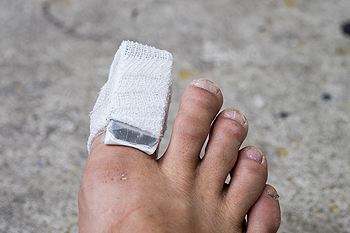 Many bones are located in the foot and they all work together to provide optimum balance necessary to effectively walk and run. If something heavy should fall on your toe or if you fall down, you may experience pain and discomfort due to a broken toe. You may notice the obvious symptoms, which may include bruising and swelling, or continued pain and throbbing. Research has shown the importance of having a proper diagnosis performed, which most likely will include having an X-ray taken. If a broken toe is confirmed, treatment should commence as quickly as possible. This may include taping the toe to the toe next to it, resetting the bone for more severe fractures, or undergoing surgery. Please consult with a podiatrist for advice on how to treat a broken toe.
Many bones are located in the foot and they all work together to provide optimum balance necessary to effectively walk and run. If something heavy should fall on your toe or if you fall down, you may experience pain and discomfort due to a broken toe. You may notice the obvious symptoms, which may include bruising and swelling, or continued pain and throbbing. Research has shown the importance of having a proper diagnosis performed, which most likely will include having an X-ray taken. If a broken toe is confirmed, treatment should commence as quickly as possible. This may include taping the toe to the toe next to it, resetting the bone for more severe fractures, or undergoing surgery. Please consult with a podiatrist for advice on how to treat a broken toe.
Broken toes may cause a lot of pain and should be treated as soon as possible. If you have any concerns about your feet, contact Dr. Steven Schwartz from Pennsylvania. Our doctor will treat your foot and ankle needs.
What Is a Broken Toe?
A broken toe occurs when one or more of the toe bones of the foot are broken after an injury. Injuries such as stubbing your toe or dropping a heavy object on it may cause a toe fracture.
Symptoms of a Broken Toe
- Swelling
- Pain (with/without wearing shoes)
- Stiffness
- Nail Injury
Although the injured toe should be monitored daily, it is especially important to have a podiatrist look at your toe if you have severe symptoms. Some of these symptoms include worsening or new pain that is not relieved with medication, sores, redness, or open wounds near the toe.
If you have any questions, please feel free to contact our offices located in Chambersburg, and Mcconnellsburg, PA . We offer the newest diagnostic and treatment technologies for all your foot care needs.
Remedies for Cracked Heels
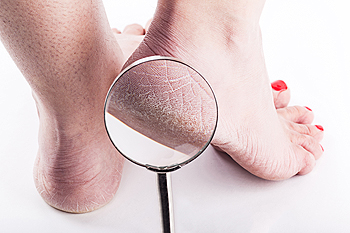 Cracked heels can be painful for your feet, and anyone of any age can develop them. This condition may even be made worse by underlying problems, such as diabetes or thyroid disease. A dry climate, a poor diet, or a poor choice of footwear can lead to the development of cracked feet. However, before seeking professional treatment, you may be able to find relief through home remedies and over-the-counter moisturizers. If these do not work for you, you may find it helpful to speak with your podiatrist regarding ways to treat your cracked heels.
Cracked heels can be painful for your feet, and anyone of any age can develop them. This condition may even be made worse by underlying problems, such as diabetes or thyroid disease. A dry climate, a poor diet, or a poor choice of footwear can lead to the development of cracked feet. However, before seeking professional treatment, you may be able to find relief through home remedies and over-the-counter moisturizers. If these do not work for you, you may find it helpful to speak with your podiatrist regarding ways to treat your cracked heels.
If the skin on your feet starts to crack, you may want to see a podiatrist to find treatment. If you have any concerns, contact Dr. Steven Schwartz from Pennsylvania. Our doctor can provide the care you need to keep you pain-free and on your feet.
Cracked Heels
It is important to moisturize your cracked heels in order to prevent pain, bleeding, and infection. The reason cracked heels form is because the skin on the foot is too dry to support the immense pressure placed on them. When the foot expands, the dry skin on the foot begins to split.
Ways to Help Heal Them
- Invest in a good foot cream
- Try Using Petroleum Jelly
- Ease up on Soaps
- Drink Plenty of Water
Ways to Prevent Cracked Heels
- Moisturize After Showering
- Skip a Shower
- Keep Shower Water Lukewarm
- Don’t Scrub Your Feet
If you are unsure how to proceed in treating cracked heels, seek guidance from a podiatrist. Your doctor will help you with any questions or information you may need.
If you have any questions, please feel free to contact our offices located in Chambersburg, and Mcconnellsburg, PA . We offer the newest diagnostic and treatment technologies for all your foot care needs.
Foods That Will Lessen Your Chance of Gout Development
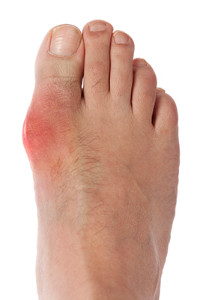 If you have gout, it is more than likely that your diet contains more purine than what is necessary. If you fail to take action against the amount of purine in your body, your kidney function will become disrupted. Purine is a substance that, when broken down, creates uric acid, which is filtered by the kidneys. A balanced amount of uric acid will help regulate blood throughout the body by promoting healthy blood vessel linings. When there is an excessive amount of uric acid in the bloodstream, urate crystals gather in the joints, which creates a condition called gout. If you are looking to avoid developing gout, you should avoid foods that are high in purines such as animal organs, sardines, alcohol, and yeast. Foods that contain a moderate amount of purine are oatmeal, bacon, oyster, spinach, sausage, and shrimp. Foods that are low in purine are rice, pasta, tofu, peanut butter, low-fat dairy products, and green olives. Research has shown that there is an inverse relationship with uric acid levels and the amount of low-fat dairy products consumed. It is important that you carefully plan your diet if you are aiming to prevent the development of gout.
If you have gout, it is more than likely that your diet contains more purine than what is necessary. If you fail to take action against the amount of purine in your body, your kidney function will become disrupted. Purine is a substance that, when broken down, creates uric acid, which is filtered by the kidneys. A balanced amount of uric acid will help regulate blood throughout the body by promoting healthy blood vessel linings. When there is an excessive amount of uric acid in the bloodstream, urate crystals gather in the joints, which creates a condition called gout. If you are looking to avoid developing gout, you should avoid foods that are high in purines such as animal organs, sardines, alcohol, and yeast. Foods that contain a moderate amount of purine are oatmeal, bacon, oyster, spinach, sausage, and shrimp. Foods that are low in purine are rice, pasta, tofu, peanut butter, low-fat dairy products, and green olives. Research has shown that there is an inverse relationship with uric acid levels and the amount of low-fat dairy products consumed. It is important that you carefully plan your diet if you are aiming to prevent the development of gout.
Gout is a foot condition that requires certain treatment and care. If you are seeking treatment, contact Dr. Steven Schwartz from Pennsylvania. Our doctor will treat your foot and ankle needs.
What Is Gout?
Gout is a type of arthritis caused by a buildup of uric acid in the bloodstream. It often develops in the foot, especially the big toe area, although it can manifest in other parts of the body as well. Gout can make walking and standing very painful and is especially common in diabetics and the obese.
People typically get gout because of a poor diet. Genetic predisposition is also a factor. The children of parents who have had gout frequently have a chance of developing it themselves.
Gout can easily be identified by redness and inflammation of the big toe and the surrounding areas of the foot. Other symptoms include extreme fatigue, joint pain, and running high fevers. Sometimes corticosteroid drugs can be prescribed to treat gout, but the best way to combat this disease is to get more exercise and eat a better diet.
If you have any questions please feel free to contact our offices located in Chambersburg, and Mcconnellsburg, PA . We offer the newest diagnostic and treatment technologies for all your foot and ankle needs.
Causes of Swollen Feet During Pregnancy
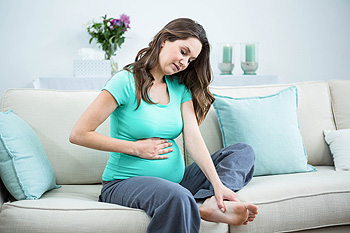 Many women enjoy being pregnant, but will often complain about their feet becoming swollen as the pregnancy progresses. It’s a common condition that often develops as a result of excess fluid the body produces in addition to pressure exerted from the growing baby. Most of the swelling will dissipate after the baby is born, but until then, there are specific ways to find moderate relief. Research has shown the importance of lying on your left side while sleeping, in addition to consuming plenty of water and exercising regularly. The majority of pregnant women may find that elevating their feet as often as possible and not standing for extended periods of time may help to reduce a portion of the swelling. If you are pregnant and are experiencing severely swollen feet, please consult with a podiatrist for additional information on how to properly care for your feet.
Many women enjoy being pregnant, but will often complain about their feet becoming swollen as the pregnancy progresses. It’s a common condition that often develops as a result of excess fluid the body produces in addition to pressure exerted from the growing baby. Most of the swelling will dissipate after the baby is born, but until then, there are specific ways to find moderate relief. Research has shown the importance of lying on your left side while sleeping, in addition to consuming plenty of water and exercising regularly. The majority of pregnant women may find that elevating their feet as often as possible and not standing for extended periods of time may help to reduce a portion of the swelling. If you are pregnant and are experiencing severely swollen feet, please consult with a podiatrist for additional information on how to properly care for your feet.
Pregnant women with swollen feet can be treated with a variety of different methods that are readily available. For more information about other cures for swollen feet during pregnancy, consult with Dr. Steven Schwartz from Pennsylvania. Our doctor will attend to all of your foot and ankle needs.
What Foot Problems Can Arise During Pregnancy?
One problem that can occur is overpronation, which occurs when the arch of the foot flattens and tends to roll inward. This can cause pain and discomfort in your heels while you’re walking or even just standing up, trying to support your baby.
Another problem is edema, or swelling in the extremities. This often affects the feet during pregnancy but tends to occur in the later stages.
How Can I Keep My Feet Healthy During Pregnancy?
- Wearing orthotics can provide extra support for the feet and help distribute weight evenly
- Minimize the amount of time spent walking barefoot
- Wear shoes with good arch support
- Wear shoes that allow for good circulation to the feet
- Elevate feet if you experience swelling
- Massage your feet
- Get regular, light exercise, such as walking, to promote blood circulation to the feet
If you have any questions please feel free to contact our offices located in Chambersburg, and Mcconnellsburg, PA . We offer the newest diagnostic and treatment technologies for all your foot and ankle needs.
Mets’ Cespedes Dealing with Calcification in Heels
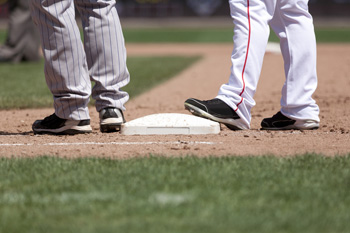 Yoenis Cespedes of the New York Mets recently announced that he is considering getting surgery to repair the calcification in his heels. Although he homered in the team’s win against the Yankees, he wasn’t scheduled to be in the remaining two games of the series. Cespedes claims the root of his medical problems have been a heel ailment that he has been dealing with for years. If he does opt for surgery, the recovery time is expected to be 8-10 months. However, this is considered to be a last-resort option for the outfielder. John Ricco, who is currently the assistant GM of the Mets said, “The way you treat this is with various conservative methods whether they be orthotics, stretching, anti-inflammatories and that’s kinda how he’s managed those symptoms over the past years.” If you are suffering from heel spurs, you should make an appointment with your podiatrist to explore your treatment options.
Yoenis Cespedes of the New York Mets recently announced that he is considering getting surgery to repair the calcification in his heels. Although he homered in the team’s win against the Yankees, he wasn’t scheduled to be in the remaining two games of the series. Cespedes claims the root of his medical problems have been a heel ailment that he has been dealing with for years. If he does opt for surgery, the recovery time is expected to be 8-10 months. However, this is considered to be a last-resort option for the outfielder. John Ricco, who is currently the assistant GM of the Mets said, “The way you treat this is with various conservative methods whether they be orthotics, stretching, anti-inflammatories and that’s kinda how he’s managed those symptoms over the past years.” If you are suffering from heel spurs, you should make an appointment with your podiatrist to explore your treatment options.
Heel spurs can be incredibly painful and sometimes may make you unable to participate in physical activities. To get medical care for your heel spurs, contact Dr. Steven Schwartz from Pennsylvania. Our doctor will do everything possible to treat your condition.
Heels Spurs
Heel spurs are formed by calcium deposits on the back of the foot where the heel is. This can also be caused by small fragments of bone breaking off one section of the foot, attaching onto the back of the foot. Heel spurs can also be bone growth on the back of the foot and may grow in the direction of the arch of the foot.
Older individuals usually suffer from heel spurs and pain sometimes intensifies with age. One of the main condition's spurs are related to is plantar fasciitis.
Pain
The pain associated with spurs is often because of weight placed on the feet. When someone is walking, their entire weight is concentrated on the feet. Bone spurs then have the tendency to affect other bones and tissues around the foot. As the pain continues, the feet will become tender and sensitive over time.
Treatments
There are many ways to treat heel spurs. If one is suffering from heel spurs in conjunction with pain, there are several methods for healing. Medication, surgery, and herbal care are some options.
If you have any questions feel free to contact our offices located in Chambersburg, and Mcconnellsburg, PA . We offer the latest in diagnostic and treatment technology to meet your needs.
The Difficulties Caused by Peripheral Neuropathy
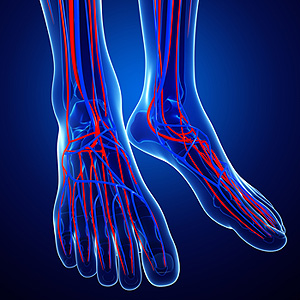 Peripheral neuropathy is a crippling condition that can potentially limit one’s ability to move. Additionally, peripheral neuropathy may increase your likelihood of falling down and this can lead to severe injury. It has been found that exercise can get rid of some effects of nerve damage. When you exercise, you are building your strength and promoting balance which will in turn, help improve the condition of the nerves and inhibit their deterioration. In many cases, the cause of peripheral neuropathy is unknown, and as a result, it makes it difficult to treat the condition.
Peripheral neuropathy is a crippling condition that can potentially limit one’s ability to move. Additionally, peripheral neuropathy may increase your likelihood of falling down and this can lead to severe injury. It has been found that exercise can get rid of some effects of nerve damage. When you exercise, you are building your strength and promoting balance which will in turn, help improve the condition of the nerves and inhibit their deterioration. In many cases, the cause of peripheral neuropathy is unknown, and as a result, it makes it difficult to treat the condition.
Neuropathy
Neuropathy can be a potentially serious condition, especially if it is left undiagnosed. If you have any concerns that you may be experiencing nerve loss in your feet, consult with Dr. Steven Schwartz from Pennsylvania. Our doctor will assess your condition and provide you with quality foot and ankle treatment for neuropathy.
What Is Neuropathy?
Neuropathy is a condition that leads to damage to the nerves in the body. Peripheral neuropathy, or neuropathy that affects your peripheral nervous system, usually occurs in the feet. Neuropathy can be triggered by a number of different causes. Such causes include diabetes, infections, cancers, disorders, and toxic substances.
Symptoms of Neuropathy Include:
- Numbness
- Sensation loss
- Prickling and tingling sensations
- Throbbing, freezing, burning pains
- Muscle weakness
Those with diabetes are at serious risk due to being unable to feel an ulcer on their feet. Diabetics usually also suffer from poor blood circulation. This can lead to the wound not healing, infections occurring, and the limb may have to be amputated.
Treatment
To treat neuropathy in the foot, podiatrists will first diagnose the cause of the neuropathy. Figuring out the underlying cause of the neuropathy will allow the podiatrist to prescribe the best treatment, whether it be caused by diabetes, toxic substance exposure, infection, etc. If the nerve has not died, then it’s possible that sensation may be able to return to the foot.
Pain medication may be issued for pain. Electrical nerve stimulation can be used to stimulate nerves. If the neuropathy is caused from pressure on the nerves, then surgery may be necessary.
If you have any questions, please feel free to contact our offices located in Chambersburg, and Mcconnellsburg, PA . We offer the newest diagnostic and treatment technologies for all your foot care needs.
Manager Gives Boy with Clubfoot a Pair of Shoes
 An 8-year-old boy named Landon from Minnesota was born with a condition called clubfoot. Clubfoot is a birth defect that causes the foot to be twisted out of shape. In Landon’s specific case, his foot is turned up and in. Throughout his life, he has worn several foot braces and casts to try to correct the alignment of his foot. Unfortunately, the casts stunted the growth of Landon’s foot, which made shoe shopping difficult for him. One of his feet is a size three, while the other is a size six. Consequently, Landon’s mother would be forced to buy two pairs of shoes and take one shoe from each pair for Landon’s feet. When the young boy and his mother discovered this problem at a shoe store in Minnesota, the store manager offered to buy one pair of shoes for the boy. The news of this act of kindness went viral on social media, gaining 2,000 shares in less than 24 hours.
An 8-year-old boy named Landon from Minnesota was born with a condition called clubfoot. Clubfoot is a birth defect that causes the foot to be twisted out of shape. In Landon’s specific case, his foot is turned up and in. Throughout his life, he has worn several foot braces and casts to try to correct the alignment of his foot. Unfortunately, the casts stunted the growth of Landon’s foot, which made shoe shopping difficult for him. One of his feet is a size three, while the other is a size six. Consequently, Landon’s mother would be forced to buy two pairs of shoes and take one shoe from each pair for Landon’s feet. When the young boy and his mother discovered this problem at a shoe store in Minnesota, the store manager offered to buy one pair of shoes for the boy. The news of this act of kindness went viral on social media, gaining 2,000 shares in less than 24 hours.
The health of a child’s feet is vital to their overall well-being. If you have any questions regarding foot health, contact Dr. Steven Schwartz of Pennsylvania. Our doctor can provide the care you need to keep you pain-free and on your feet.
Tips for Keeping Children's Feet Healthy
- Make sure their shoes fit properly
- Look for any signs of in-toeing or out-toeing
- Check to see if they have Clubfoot (condition that affects your child’s foot and ankle, twisting the heel and toes inward) which is one of the most common nonmajor birth defects.
- Lightly cover your baby’s feet (Tight covers may keep your baby from moving their feet freely, and could prevent normal development)
- Allow your toddler to go shoeless (Shoes can be restricting for a young child’s foot)
- Cut toenails straight across to avoid ingrown toenails
- Keep your child’s foot clean and dry
- Cover cuts and scrapes. Wash any scratches with soap and water and cover them with a bandage until they’ve healed.
If you have any questions, please feel free to contact our offices located in Chambersburg, and Mcconnellsburg, PA . We offer the newest diagnostic and treatment technologies for all your foot care needs.
What are the Different Types of Corns?
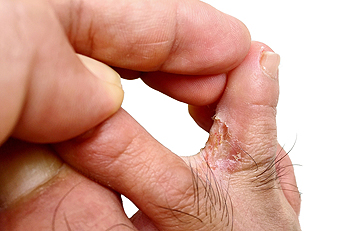 Corns will typically develop on the pinky toe or between the toes as a result of pressure and friction. A common cause of the development of this condition, is from shoes that do not fit correctly, which causes the toes to have inadequate room to move about. This painful ailment may cause pain to exist inside the toe, and this may be a result of the pressure that is exerted on sensitive nerves. Corns are divided into two categories, and are referred to as hard or soft corns. The latter will exist in between the toes and will thrive in moist environments. Hard corns typically form on the tops of the toes where that portion of the toe meets the shoe. Corns can be prevented by choosing to wear shoes that fit properly. If you are experiencing hard or soft corns, it’s advised to consult with a podiatrist who can suggest proper treatment options that are correct for you.
Corns will typically develop on the pinky toe or between the toes as a result of pressure and friction. A common cause of the development of this condition, is from shoes that do not fit correctly, which causes the toes to have inadequate room to move about. This painful ailment may cause pain to exist inside the toe, and this may be a result of the pressure that is exerted on sensitive nerves. Corns are divided into two categories, and are referred to as hard or soft corns. The latter will exist in between the toes and will thrive in moist environments. Hard corns typically form on the tops of the toes where that portion of the toe meets the shoe. Corns can be prevented by choosing to wear shoes that fit properly. If you are experiencing hard or soft corns, it’s advised to consult with a podiatrist who can suggest proper treatment options that are correct for you.
Corns can make walking very painful and should be treated immediately. If you have questions regarding your feet and ankles, contact Dr. Steven Schwartz of Pennsylvania. Our doctor will treat your foot and ankle needs.
Corns: What Are They? And How Do You Get Rid of Them?
Corns are thickened areas on the skin that can become painful. They are caused by excessive pressure and friction on the skin. Corns press into the deeper layers of the skin and are usually round in shape.
Ways to Prevent Corns
There are many ways to get rid of painful corns such as:
- Wearing properly fitting shoes that have been measured by a professional
- Wearing shoes that are not sharply pointed or have high heels
- Wearing only shoes that offer support
Treating Corns
Although most corns slowly disappear when the friction or pressure stops, this isn’t always the case. Consult with your podiatrist to determine the best treatment option for your case of corns.
If you have any questions please feel free to contact our offices located in Chambersburg, and Mcconnellsburg, PA . We offer the newest diagnostic and treatment technologies for all your foot and ankle needs.
Possible Causes of Poor Circulation in the Feet
 Many people experience poor circulation in the feet, and this is typically a result of inadequate blood flow throughout the body. There are specific symptoms the majority of people experience, including cold feet and toes in warm weather as well as cold weather, a tingling or numbing sensation, and memory loss or dizzy spells. Recent research has shown that smoking may contribute to this condition in addition to a lack of exercise. Eating unhealthy foods, which leads to obesity, may also be a cause of poor circulation. Small lifestyle improvements may help in managing this condition. If you are afflicted with this ailment, it's important to schedule a consultation with a podiatrist for suggestions on how to manage poor circulation in the feet.
Many people experience poor circulation in the feet, and this is typically a result of inadequate blood flow throughout the body. There are specific symptoms the majority of people experience, including cold feet and toes in warm weather as well as cold weather, a tingling or numbing sensation, and memory loss or dizzy spells. Recent research has shown that smoking may contribute to this condition in addition to a lack of exercise. Eating unhealthy foods, which leads to obesity, may also be a cause of poor circulation. Small lifestyle improvements may help in managing this condition. If you are afflicted with this ailment, it's important to schedule a consultation with a podiatrist for suggestions on how to manage poor circulation in the feet.
While poor circulation itself isn’t a condition; it is a symptom of another underlying health condition you may have. If you have any concerns with poor circulation in your feet contact Dr. Steven Schwartz of Pennsylvania. Our doctor will treat your foot and ankle needs.
Poor Circulation in the Feet
Peripheral artery disease (PAD) can potentially lead to poor circulation in the lower extremities. PAD is a condition that causes the blood vessels and arteries to narrow. In a linked condition called atherosclerosis, the arteries stiffen up due to a buildup of plaque in the arteries and blood vessels. These two conditions can cause a decrease in the amount of blood that flows to your extremities, therefore resulting in pain.
Symptoms
Some of the most common symptoms of poor circulation are:
- Numbness
- Tingling
- Throbbing or stinging pain in limbs
- Pain
- Muscle Cramps
Treatment for poor circulation often depends on the underlying condition that causes it. Methods for treatment may include insulin for diabetes, special exercise programs, surgery for varicose veins, or compression socks for swollen legs.
As always, see a podiatrist as he or she will assist in finding a regimen that suits you. A podiatrist can also prescribe you any needed medication.
If you have any questions, please feel free to contact our offices located in Chambersburg, and Mcconnellsburg, PA . We offer the newest diagnostic and treatment technologies for all your foot care needs.

